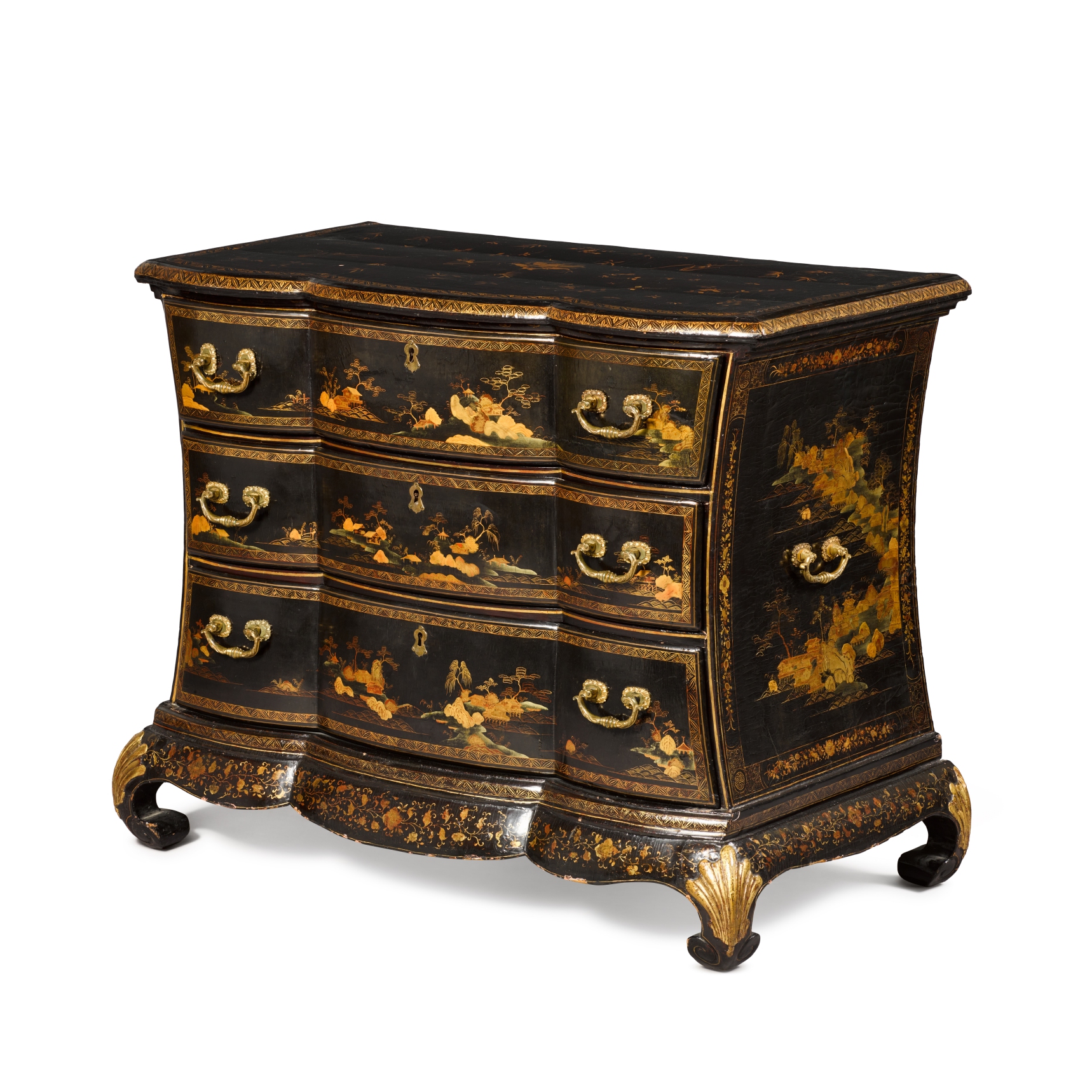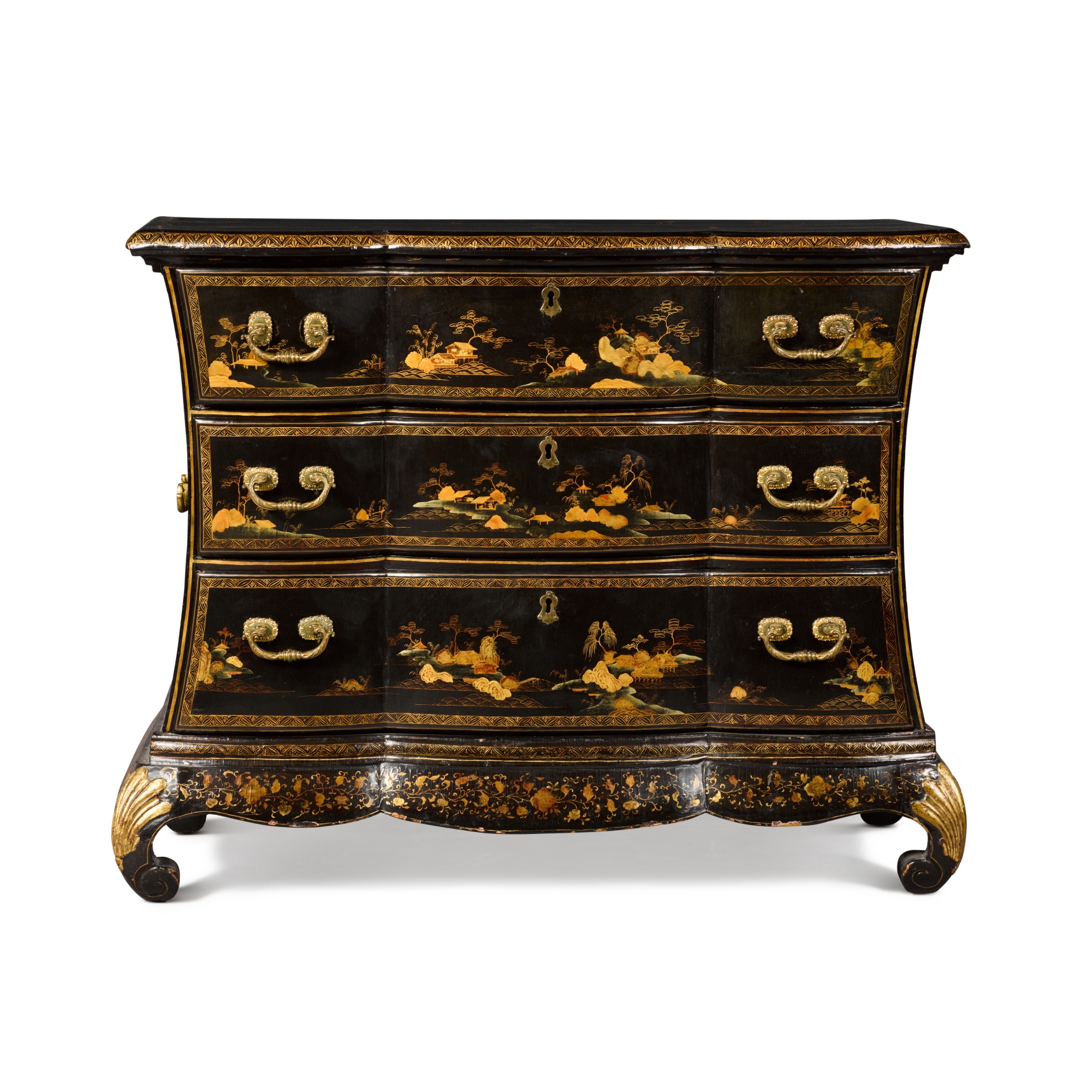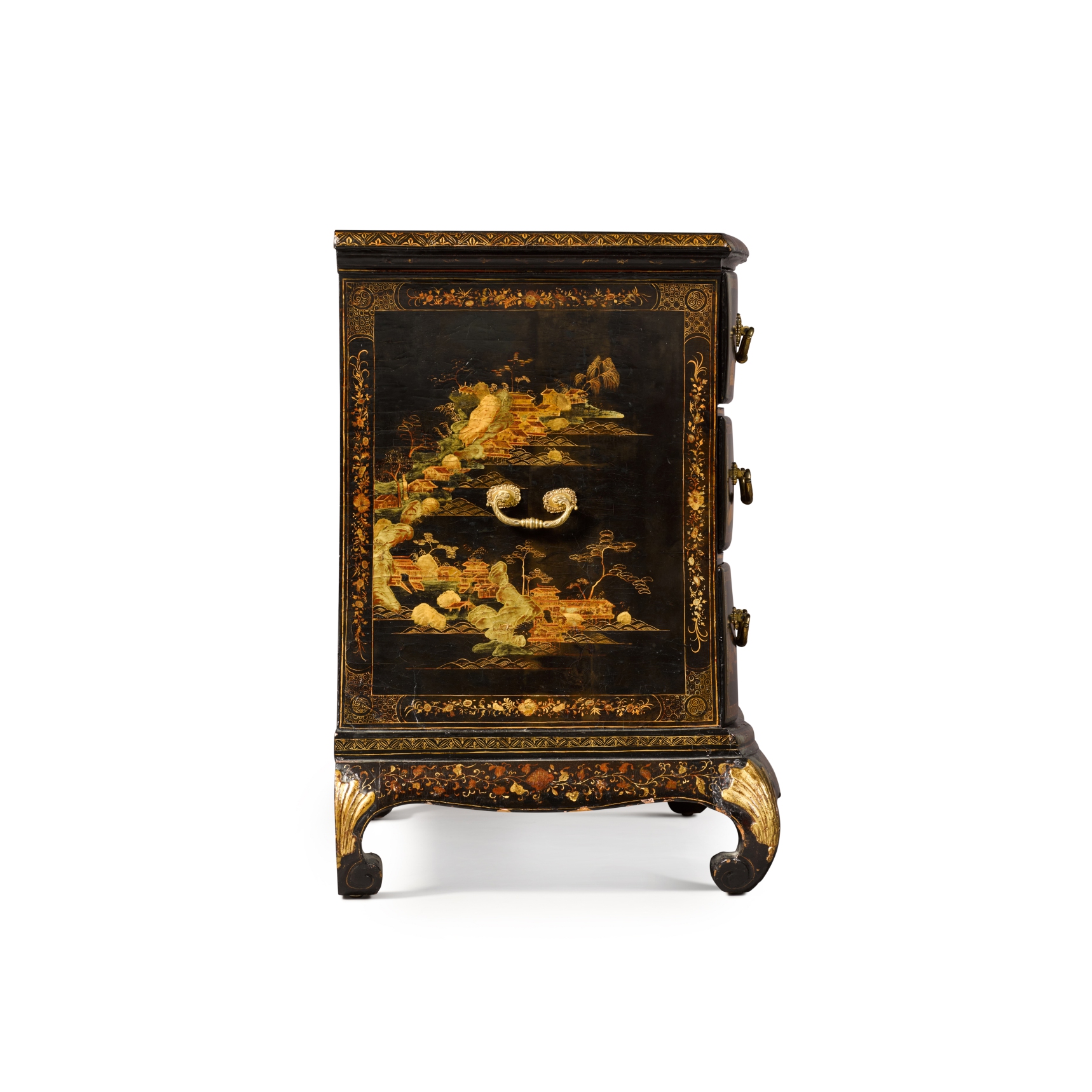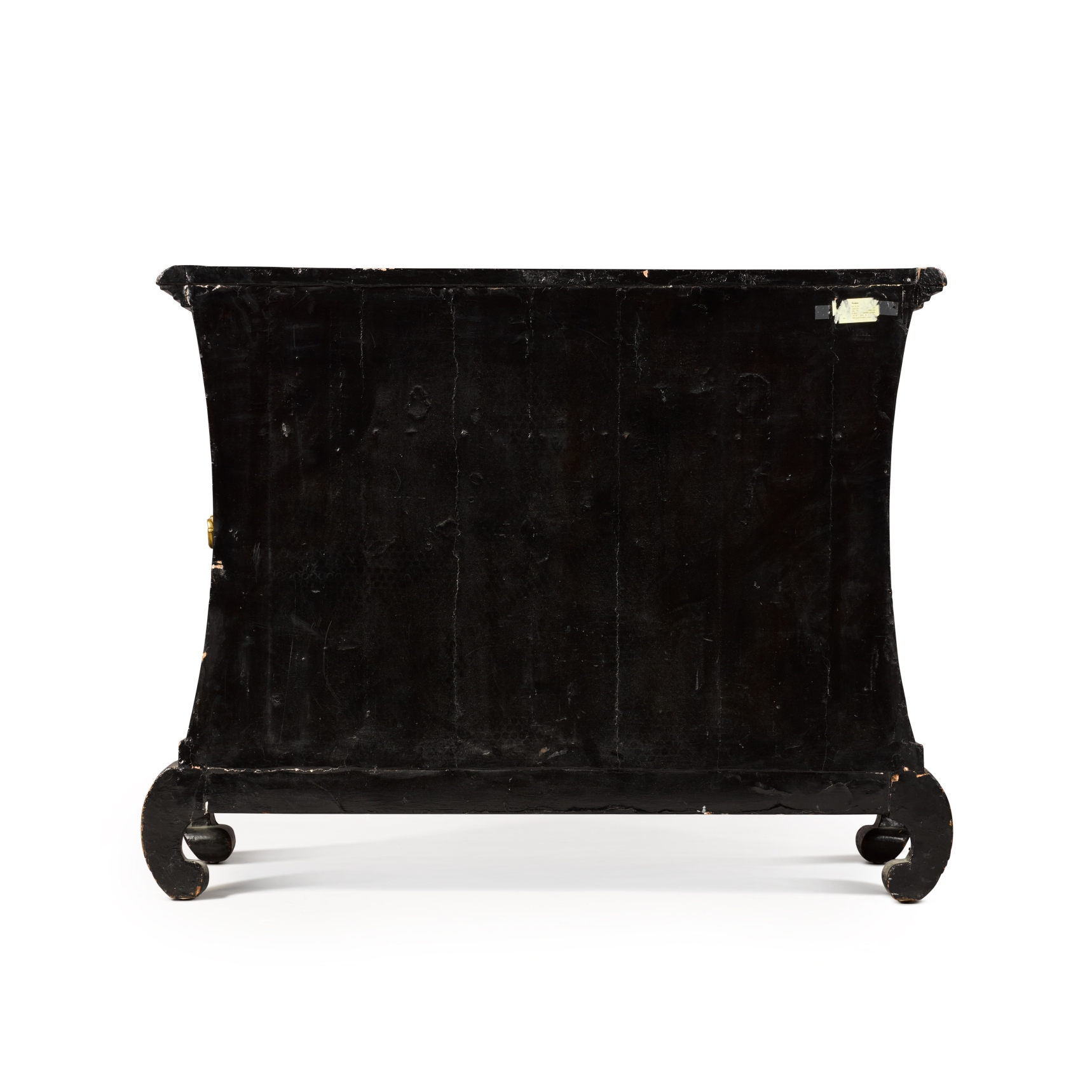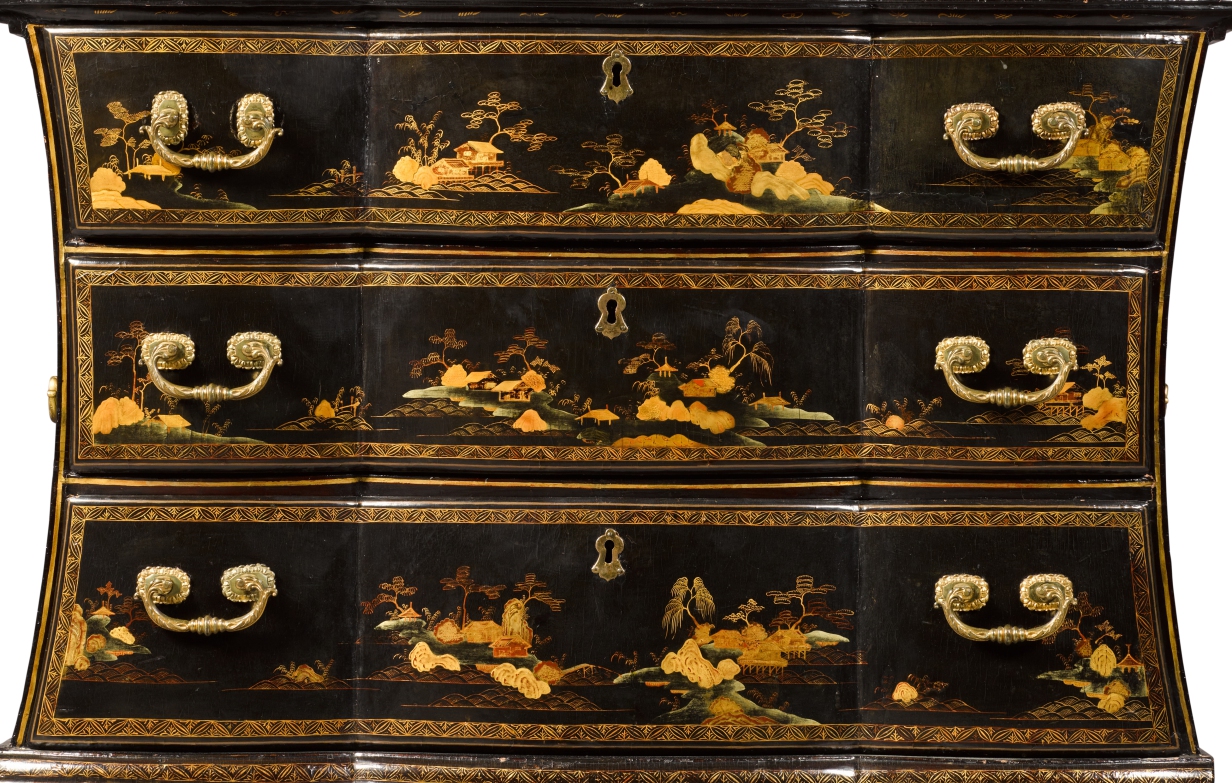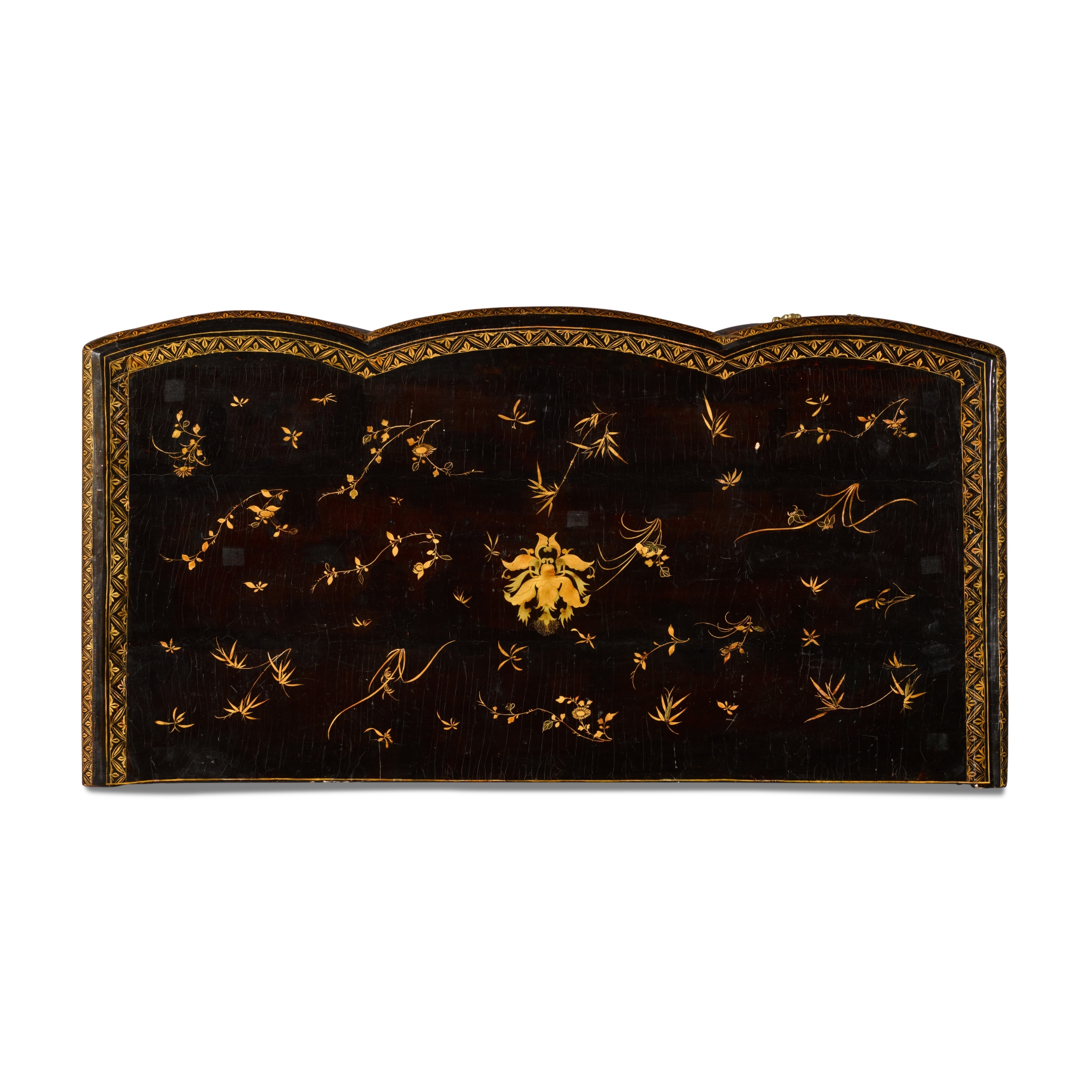59
A Chinese export black gilt and polychrome lacquer commode, mid-18th century
A Chinese export black gilt and polychrome lacquer commode, mid-18th century
of serpentine form, the lacquer decorated throughout with landscapes and foliate tendrils, with three drawers on scroll feet with shell carving
88.7cm. high, 114cm. wide, 58cm. deep;
2ft. 11 in., 3ft. 8 7/8in., 1ft. 10 7/8in.
Provenance
Sotheby's New York, 20 November 1993, lot 208;
Christie's London, 16 November 1995, lot 39;
Christie's New York, 6th June 2013, lot 4.
Catalogue note
As well as incorporating lacquer panels into furniture of European manufacture, one of the ways in which the European appetite for evocative chinoiserie décor was satisfied was through the import of Chinese-constructed furniture made for the European market. These were usually shipped from in the province of Canton (Guangzhou), and were either made after prints depicting European forms of furniture, or copied directly from European models brought to China by boat. The costs of transport compounded with labour costs meant that export lacquerware was a highly expensive luxury product, and the supply was even more restricted for bulky furniture: the number of items that were permitted on board the ships going back to Europe varied based on a seaman’s rank, meaning that most could only bring smaller items and only officers could bring back larger export pieces like furniture.1 Furniture made in China to designs that were suited to European living and interiors were therefore highly prized for eighteenth-century collectors.
Chinese Export furniture in lacquer can be seen in several significant collections, such as two cabinets in the V&A (W.28:1 to 6-1935) and the Royal Collection (RCIN 27879). Commodes in this form have previously been associated with the Danish market in particular. The taste for chinoserie was as fierce in Denmark as elsewhere, and a Royal Danish Asiatic Company was created in 1732 to foster trade with China. There is a significant collection of Chinese export furniture in lacquer at Fredensborg Palace, including a set of 12 chairs that were first inventoried in 1755, are still there today and can be cross-referenced with a bill issued to Christian VI in 1737.2 Examples of export lacquer commodes for the Danish market have also sold at Christie’s New York, 22nd October 2013, lot 118 and at Christie’s New York, 2nd June 2015, lot 156. A Chinese export bureau cabinet made for the Danish market also features a gilt carved shell on a low base, in a way that is similar to the present lot (sold Christie’s New York, 24th November 2009, lot 84). However, Chinese interpretations of European forms can vary drastically from commission to commission: Margaret Jourdain and R. Soame Jenyns note that “in Chinese furniture for the European market, curved elements are usually exaggerated”,3 and this can be observed in the concave sides of the present commode, which are highly unusual. Another feature of note on the present commode is its remarkably well-preserved lacquer surface, which is vivid and has relatively little wear and damage given the age of the piece.
1 Tove Clemmensen, ‘Some Furniture made in China in the English Style, Exported from Canton to Denmark 1735,1737 and 1738’, Furniture History, 1985, pp.174-5.
2 Ibid., p.175.
3 Margaret Jourdain and R. Soame Jenyns, Chinese Export Art in the Eighteenth Century, London, 1950, p.24.
Additional Notices & Disclaimers
Please note that Condition 12 of the Conditions of Business for Buyers (Online Only) is not applicable to this lot.
A Chinese export black gilt and polychrome lacquer commode, mid-18th century
of serpentine form, the lacquer decorated throughout with landscapes and foliate tendrils, with three drawers on scroll feet with shell carving
88.7cm. high, 114cm. wide, 58cm. deep;
2ft. 11 in., 3ft. 8 7/8in., 1ft. 10 7/8in.
Provenance
Sotheby's New York, 20 November 1993, lot 208;
Christie's London, 16 November 1995, lot 39;
Christie's New York, 6th June 2013, lot 4.
Catalogue note
As well as incorporating lacquer panels into furniture of European manufacture, one of the ways in which the European appetite for evocative chinoiserie décor was satisfied was through the import of Chinese-constructed furniture made for the European market. These were usually shipped from in the province of Canton (Guangzhou), and were either made after prints depicting European forms of furniture, or copied directly from European models brought to China by boat. The costs of transport compounded with labour costs meant that export lacquerware was a highly expensive luxury product, and the supply was even more restricted for bulky furniture: the number of items that were permitted on board the ships going back to Europe varied based on a seaman’s rank, meaning that most could only bring smaller items and only officers could bring back larger export pieces like furniture.1 Furniture made in China to designs that were suited to European living and interiors were therefore highly prized for eighteenth-century collectors.
Chinese Export furniture in lacquer can be seen in several significant collections, such as two cabinets in the V&A (W.28:1 to 6-1935) and the Royal Collection (RCIN 27879). Commodes in this form have previously been associated with the Danish market in particular. The taste for chinoserie was as fierce in Denmark as elsewhere, and a Royal Danish Asiatic Company was created in 1732 to foster trade with China. There is a significant collection of Chinese export furniture in lacquer at Fredensborg Palace, including a set of 12 chairs that were first inventoried in 1755, are still there today and can be cross-referenced with a bill issued to Christian VI in 1737.2 Examples of export lacquer commodes for the Danish market have also sold at Christie’s New York, 22nd October 2013, lot 118 and at Christie’s New York, 2nd June 2015, lot 156. A Chinese export bureau cabinet made for the Danish market also features a gilt carved shell on a low base, in a way that is similar to the present lot (sold Christie’s New York, 24th November 2009, lot 84). However, Chinese interpretations of European forms can vary drastically from commission to commission: Margaret Jourdain and R. Soame Jenyns note that “in Chinese furniture for the European market, curved elements are usually exaggerated”,3 and this can be observed in the concave sides of the present commode, which are highly unusual. Another feature of note on the present commode is its remarkably well-preserved lacquer surface, which is vivid and has relatively little wear and damage given the age of the piece.
1 Tove Clemmensen, ‘Some Furniture made in China in the English Style, Exported from Canton to Denmark 1735,1737 and 1738’, Furniture History, 1985, pp.174-5.
2 Ibid., p.175.
3 Margaret Jourdain and R. Soame Jenyns, Chinese Export Art in the Eighteenth Century, London, 1950, p.24.
Additional Notices & Disclaimers
Please note that Condition 12 of the Conditions of Business for Buyers (Online Only) is not applicable to this lot.
Classic Design: Furniture, Clocks, Silver & Ceramics
Sale Date(s)
Venue Address
General delivery information available from the auctioneer
Sotheby’s Post Sale Service teams can arrange expert delivery and convenient shipping of your property. We offer exceptional service and competitive rates whether shipping a diamond bracelet or a large piece of furniture. Fully knowledgeable on all international regulations, Sotheby's will compile a full range of services for you, including collection, packing and arranging for shipping and transit insurance worldwide. For sales in London and New York, simply provide us with your delivery address when you register for a sale. Following your purchase, we will send you a competitive and comprehensive shipping quote. For property purchased in all other salerooms, contact that office directly to arrange for the transport of your purchases.
To learn more, or if we may be of assistance contact us.













